An unexpected side effect of the coronavirus? A new urgency about helping homeless people
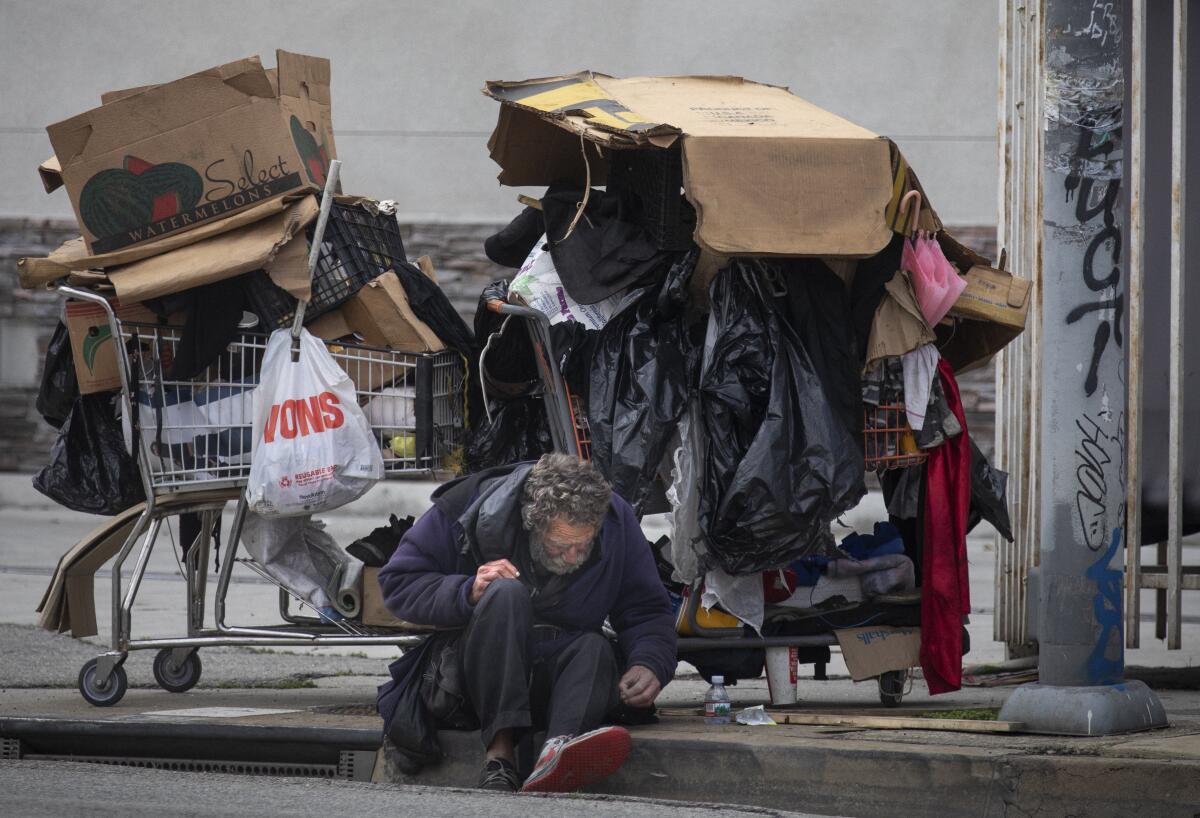
- Share via
As public health officials scramble to manage the spread of the novel coronavirus, strategies are starting to be implemented across California and the rest of the country to protect the homeless population.
On Sunday, Gov. Gavin Newsom announced that homeless people would be prioritized as a vulnerable population. Though he offered few details, he said there would be a massive attempt to move people off the streets and into indoor settings, including hotels and motels purchased in recent days and 450 state-owned trailers that will be deployed throughout California.
For the record:
11:25 a.m. March 16, 2020This article originally said that Randall Kuhn is a professor at UCLA’s department of community health services. He is with UCLA’s department of community health sciences.
On Friday, President Trump issued a federal emergency declaration, which will ease the funneling of Medicaid dollars to states to help low-income individuals get tested and treated for COVID-19, open emergency clinics and develop quarantine sites for those who have no place to self-isolate.
Earlier this month, the U.S. Department of Housing and Urban Development also took the unprecedented step of publishing guidelines for preventing and managing the spread of infectious diseases among people living on the streets and in shelters.
These moves are particularly crucial in California, home to half of the country’s street homeless population and more than one-fifth of the coronavirus cases reported nationwide so far.
Meanwhile, San Francisco has allocated $5 million for a series of initiatives to protect the health of the 8,000 people living on the streets or in shelters and the many more who live in single-room occupancy hotels. The city’s efforts are mostly focused on its dense northeast neighborhoods and include hiring more janitors and increasing meal services to let residents stay indoors.
In Los Angeles, hand-washing stations are being delivered to encampments throughout the city. Outreach workers are implementing new protocols, such as social distancing from their homeless clients, which will allow them to continue working on the streets, but with a lower risk of introducing an infection.
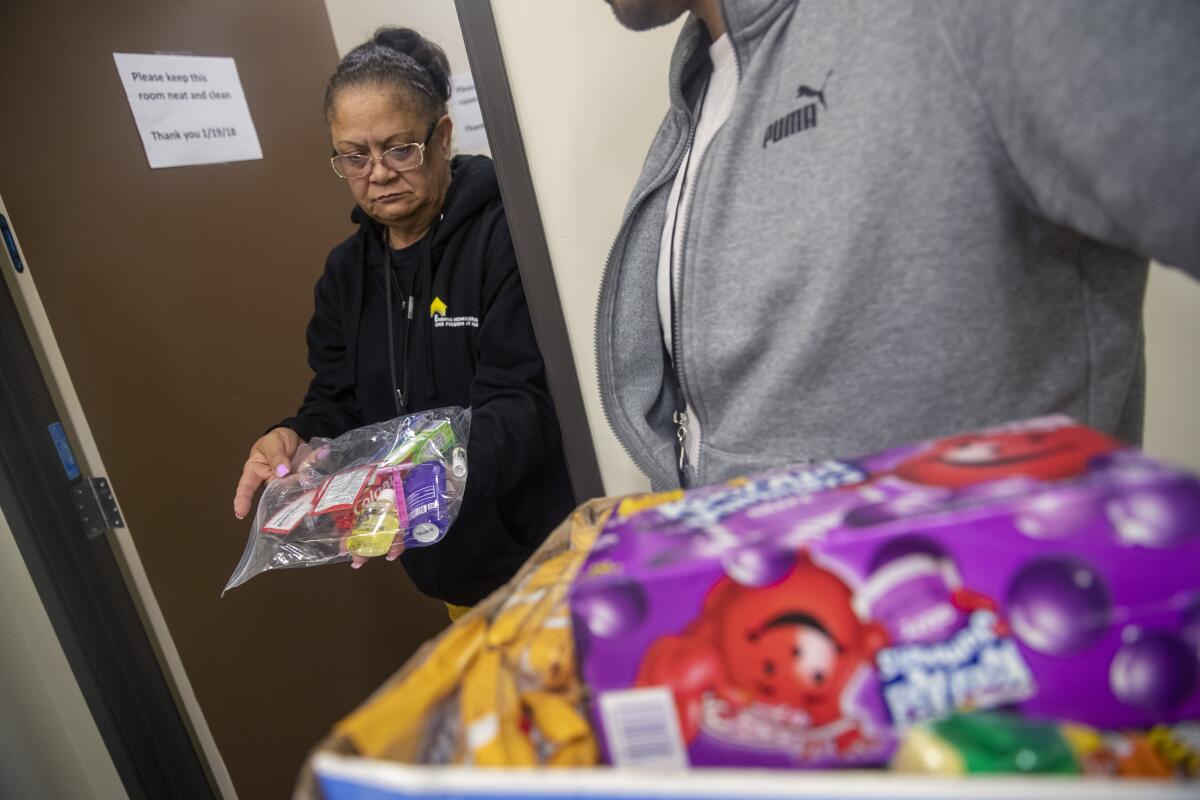
The plans in each city differ in scope, pace and ambition and reflect the specific demands of the local homeless population, which has yet to report a case of COVID-19.
Whether these approaches will be effective in the long-term remains unclear. For those living in encampments scattered throughout cities or bedding down in crowded shelters, containment or mitigation might prove elusive.
“I see one scenario where this virus mercifully dodges the homeless population or another scenario where it hits the homeless population quite hard,” said Randall Kuhn, a professor at UCLA’s department of community health sciences. “Everyone is obviously facing a serious situation. Everyone is becoming increasingly aware of how serious it is — but it is still abstract.”
Beyond the hypotheticals, however, is the hope among public health experts that the coronavirus pandemic, however temporary, will bring about a shift in homeless policies that will permanently change this troubled landscape in cities throughout America.
::
No one questions the vulnerability of homeless people.
Last year in Los Angeles County, nearly 1,100 people — ravaged by illness, addiction, suicide and exposure — died on the streets, where public health emergencies are common.
Three years ago, Hepatitis A killed 16 people in San Diego County who were either homeless or visiting encampments. Last year, an outbreak of typhus hit skid row, and more recently, trench fever, transmitted by body lice, sickened people living on the streets in Santa Monica.
Not only does the stress of living outdoors depress immunity, but mental illness, substance abuse and unsanitary living conditions — exacerbated by poor nutrition, lack of running water and toilets — create an environment conducive to the spread of disease.
But as much as homeless people are vulnerable to the effects of COVID-19, they are generally isolated from common sources of transmission, Kuhn said.
On the streets, social distancing — the best way to slow the spread of the coronavirus, public health officials say — is already being practiced. Most people already avoid homeless men and women, and encampments are typically out of the way, beneath freeways, in alleys and along riverbeds.
But while it may take longer for the virus to reach the homeless population, once it does, Kuhn said “it could spread like wildfire and potentially spread back into the general population.”
Keeping the virus from reaching homeless communities is the challenge facing public health officials.
Kuhn estimates that nearly 10,000 homeless people in L.A. County are over 60 years old and especially susceptible to the worst consequences of COVID-19. Separately, last year’s government-mandated count of the homeless population found that 13,600 men and women were 55 or older, up 7% from the prior year.
Newsom on Sunday, in addition to prioritizing the state’s homeless population, asked 5.3 million Californians over the age of 65 to isolate themselves at home. That’s impossible for older people who lack housing. But by securing motels and deploying trailers, Newsom said the state will be able to move people into “environments where we can address their growing anxiety and our growing concerns.”
On the streets, possible sources of transmission range from outreach and shelter workers, whose jobs require daily interaction with homeless people, to public spaces like libraries, restaurants and street transportation that homeless people often use.
“The reality is a typical person experiencing homelessness is at more risk of contracting a disease and affecting their health than of spreading a disease,” said Bobby Watts, head of the National Health Care for the Homeless Council.
This is especially problematic in cities like San Francisco and Los Angeles, where homeless encampments have been raised close to residential neighborhoods.
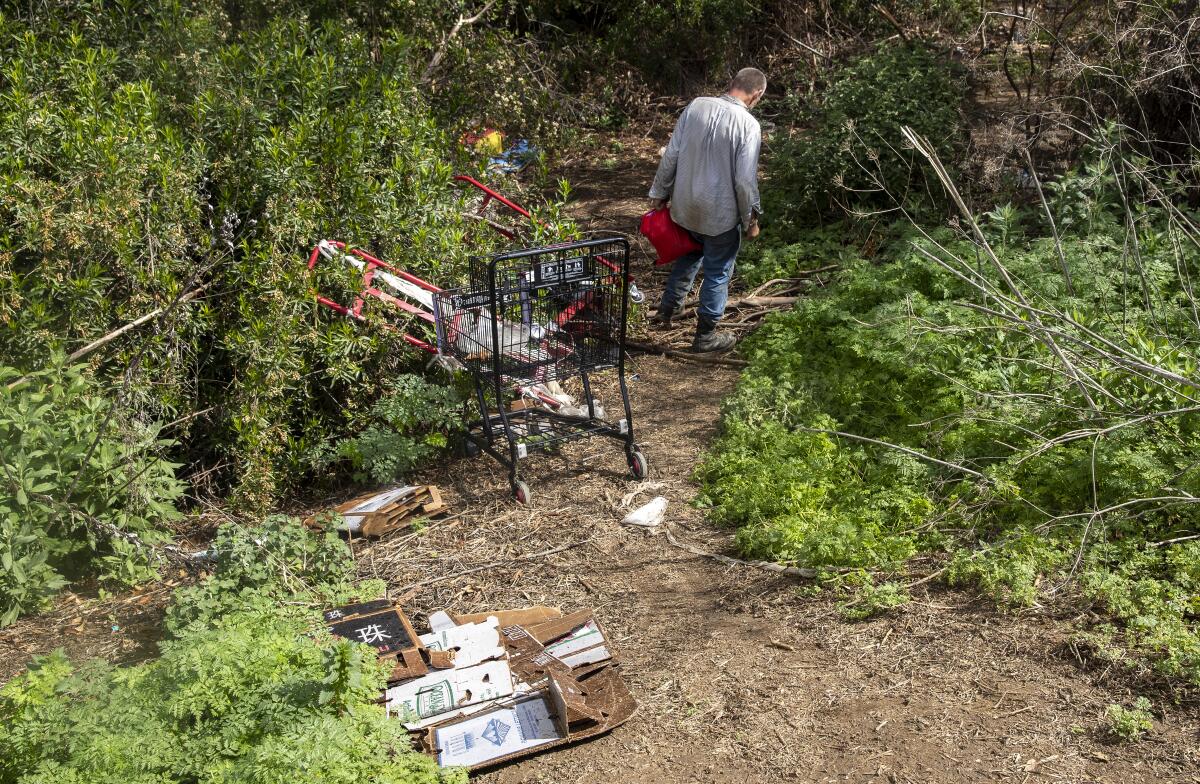
Kuhn points out that the homeless people in San Francisco are especially vulnerable to an outbreak because of its density and the physically close relationship between housed and unhoused residents.
A week after HUD issued its guidelines to prevent the spread of infectious diseases, San Francisco announced the creation of an emergency fund for the purpose of reducing exposure of the virus to people living in shelters, single-room occupancy hotels and permanent supportive housing.
In addition, the city issued a public health order that established “cleaning and contagion mitigation protocols” in settings where homeless people gather and live, including expanded shelter hours.
“For vulnerable people in SROs or shelters, this investment will help them limit their outings, by assuring that food and shelter is available, and that congregate settings are clean environments,” said Grant Colfax, director of heath for San Francisco.
The city also leased 30 recreational vehicles at a cost of $440,000 through June. Parked in the Presidio, they will be sent to specific neighborhoods to quarantine and isolate homeless people who test positive for COVID-19 and aren’t hospitalized.
For those who have been exposed to the disease but are asymptomatic, residential apartments and hotels will be available for people to self-quarantine if they don’t have a place to go.
“We have no confirmed cases of COVID-19 in our homeless or SRO populations, but we want to have resources in place, so people have a safe place to be cared for if and when that happens,” said Francis Zamora, a spokesperson for the city’s emergency management department.
Twenty hand-washing stations are also being distributed throughout the city, along with portable toilets; the city has published their locations online.
::
With its sprawl of neighborhoods made up of predominantly single-family homes, Los Angeles County might find it easier than San Francisco to mitigate the spread of the novel coronavirus among its homeless population of nearly 59,000.
In the general population, there are currently more coronavirus cases in the Bay Area than in Southern California, but elected officials and public experts suspect that could begin to change.
“Not to say we shouldn’t be deeply concerned in Los Angeles,” Kuhn said, “but it gives us a couple of days more to come up with a plan that is more tailored to our daily context.”
If San Francisco’s announcements last week constituted a blitz, a more deliberate approach is being taken south of the Tehachapis.
“We’re trying not to panic, but prepare, and there’s a fine line between those,” said Heidi Marston, executive director for Los Angeles Homeless Services Authority. “But acting with urgency is super important.”
Among her concerns is making sure that shelters across the city remain operational, especially if their staff call in sick. She said that her agency is working with providers to make sure cleaning supplies are available for janitorial services over the next three or four months.
Sarah Dusseault, who chairs the governing commission of the Los Angeles Homeless Services Authority, believes that one of the first priorities is to make sure everyone is getting the information they need. The agency set up a dedicated website to answer questions about the coronavirus and conducted a webinar with outreach workers to provide instructions before they head out onto the street.
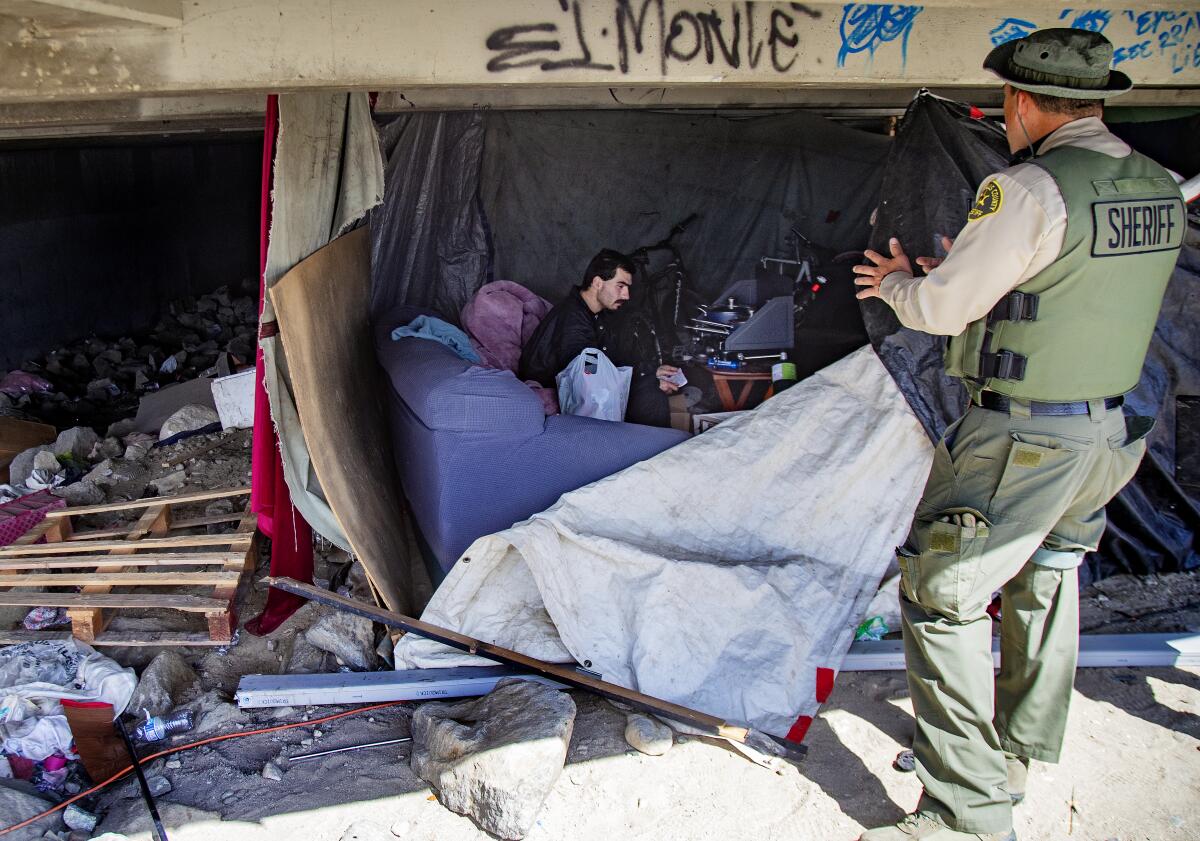
The agency, known as LAHSA, also is working with the city and county to coordinate its response to the pandemic. On Thursday, the city began delivering 100 hand-washing stations to encampments across Los Angeles, a week after the motion was presented in the City Council.
One advocacy group, however, argues that skid row alone needs nearly 480 stations, as well as more public toilets, hydration stations and mobile laundry facilities.
Still in doubt is whether the city will suspend the work of its sanitation crews who conduct periodic cleanups of encampments. These efforts, aimed at removing trash and hazardous materials and in some instances washing sidewalks, are often disruptive for the homeless residents who are forced to relocate their tents and belongings.
Last week, the city of San Jose announced it was temporarily ending the sweeps of encampments through the second week of April.
In a complex and evolving puzzle that stretches across the Los Angeles County, one missing piece is where to quarantine homeless people who are symptomatic or asymptomatic with COVID-19.
On Tuesday, Barbara Ferrer, the county’s director of public health, announced that her department and the homeless authority were working to identify a facility for individuals who might need to be quarantined for the coronavirus.
LAHSA’s Marston said a range of options are being considered, among them, an early opening of one of the recently completed bridge shelters. Another option is to lease some motels, but motel owners have expressed reservations about that plan, Marston said.
Los Angeles Deputy Mayor Christina Miller said the city is considering hospitals and recuperative care facilities as quarantine zones.
“That’s not where we’re at right now,” she said. “The best thing we can do right now is plan for that scenario.”
::
Homelessness has long been framed as a public health crisis, and the coronavirus is challenging existing safeguards. The reality of the outbreak has raised the question of whether it will be a wake-up call for understanding and more directly addressing the needs of the homeless community.
“When we think about community disaster response and emergency response, everyone in the healthcare space thinks about nursing homes and hospitals,” said Barbara DiPietro, senior director of policy for the National Health Care for the Homeless Council. “All too often, homeless populations are either forgotten or pushed to the side, not appreciated as a priority.”
DiPietro sees an opportunity to get further buy-in for providing more consistent preventative healthcare measures of the sort that have often been politically unpopular in Los Angeles and elsewhere in California.
Across the state, county departments of public health have issued guidelines for preventing the spread of the virus, and the Department of Housing and Urban Development issued its own this month, an unusual step for an agency that has expressed ambivalence toward helping low-income Americans.
Written to help limit the spread of illness in shelters and encampments, the “Infectious Disease Toolkit” provides both a broad overview — “developing a response plan” and “identifying partners and stakeholders” — and practical specifics, including installing hand-washing stations, increasing access to public restrooms and providing trash collection from encampments.
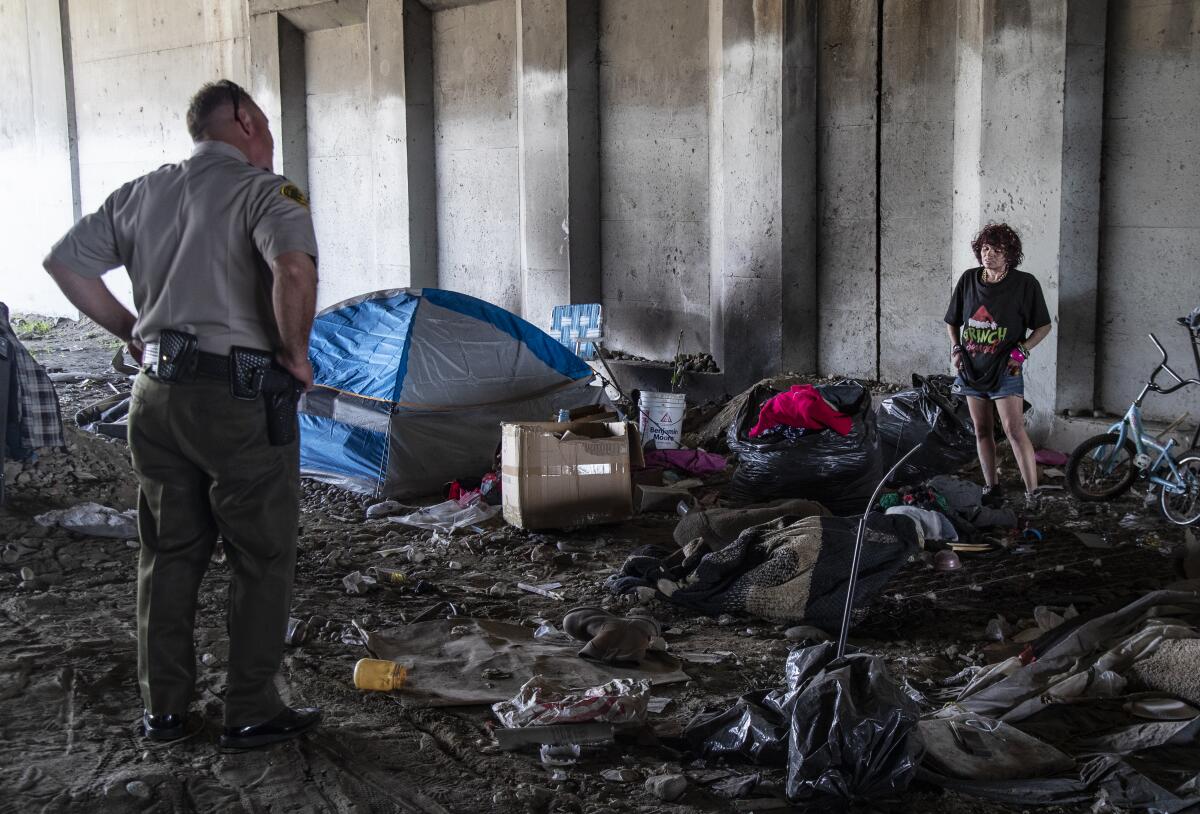
“This is extraordinary, but exactly what you would like to see,” Kuhn said. “How much you can implement these guidelines is always the question.”
Kuhn also wonders how the federal guidelines, essentially a “one-size-fits-all” approach, can be tailored to Los Angeles County, with its 10 million people and 88 cities across a region the size of Connecticut.
If outreach during the crisis improves conditions in encampments and provides visible benefits, then the changes brought by the coronavirus might last beyond the epidemic.
“These are activities necessary for daily living,” DiPietro said of emergency sanitation efforts. “Maybe the coronavirus changes how we approach these.”
Given the frequency of public health emergencies among homeless people, the health of any city depends upon whether its most marginalized residents are properly supported, experts say.
“There is the possibility that this crisis will put a light on why we have a safety net,” Kuhn said. “This has the potential to shed a broader light on how interconnected we are and how beneficial are the safety nets for preventing homelessness.”
Dusseault hopes for a similar outcome.
“Our hope,” she said, speaking of LAHSA, “is that this is an opportunity to double-down on compassion and provide health support to keep everyone safe and well.”
More to Read
Sign up for Essential California
The most important California stories and recommendations in your inbox every morning.
You may occasionally receive promotional content from the Los Angeles Times.









